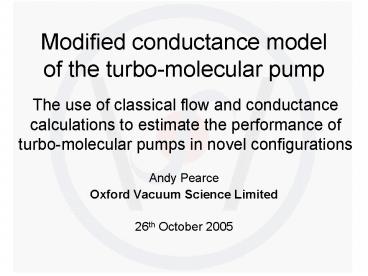Modified conductance model of the turbomolecular pump - PowerPoint PPT Presentation
1 / 22
Title:
Modified conductance model of the turbomolecular pump
Description:
Pressure calculations (ii) ... Molecule deflected down pump by impact with blade ... Impact between blade and molecule imparts momentum to molecule such that it ... – PowerPoint PPT presentation
Number of Views:80
Avg rating:3.0/5.0
Title: Modified conductance model of the turbomolecular pump
1
Modified conductance model of the turbo-molecular
pump
The use of classical flow and conductance
calculations to estimate the performance of
turbo-molecular pumps in novel configurations
- Andy Pearce
- Oxford Vacuum Science Limited
- 26th October 2005
2
History
Compact GCMS application
PEI Cell
Panalyser
3
History
GCMS split flow application
Pressure calculations
Optimise
for maximum sensitivity
Not Known
4
History
Compact GCMS application
CEI-Analyser
PEI Cell
Panalyser
He
CRSplit?
Compression Ratio
?
5
History
GCMS split flow application
Pressure calculations (ii)
Need some way of measuring / calculating split
flow pumping speed and compression ratio -
Turbo pump model
6
How does a turbo pump work?
- Traditional laymans explanation uses cricket bat
description - Molecule deflected down pump by impact with blade
- Alternative approach is to consider frame of
reference of molecule - Blade geometry appears different according to
motion of molecule
7
Blade angle modification
- Conductance for molecules entering pump is
increased
- Conductance for molecules in contra-flow is
decreased
8
Derivation of pump characteristics
Pinlet
C
C
Pstage_1
9
Derivation of pump characteristics
P1 not known
10
Derivation of pump characteristics
S expressed as function of backing pressure
11
Compression ratio, R
12
Effect of stator stages
- Impact between blade and molecule imparts
momentum to molecule such that it enters frame of
reference of blade - Stator stage in motion relative to new frame of
reference of molecule - Stator stages count as rotor stages
- Stator stages necessary to allow continued
modification for multiple pump stages
13
Derivation of (modified) conductances
- Measure geometry of pump!
- Calculate blade angles
- Calculate mach angle and therefore modified blade
angles
14
Derivation of (modified) conductances
l/s _at_ 20C
- Inlet conductance of duct not yet considered
- Some ducts have less than zero length
- More fundamental approach probably better
15
Derivation of (modified) conductances
- Angle of blades casts shadow over inlet
- Integral performed over molecular angles of
incidence to calculate resultant reduction in
conductance
16
Results
- Pumping speed typically within 20 agreement
- R within order of magnitude
- Better accuracy for light gases
- Generally model works very well for this pump
17
Results
- Speed, compression ration and pressures
calculated throughout pumping cell
- Able to balance compression and speed to maximise
EI Cell throughput
18
Results
19
Results
20
Trans-molecular flow
- Model assumes molecular flow regime
- Speed and compression ratio constant vs pressure
- At higher pressures molecule-molecule collisions
dominate - Molecules do not enter frame of reference of each
stage - Model no longer works
- Viscous flow conductances applied without
modification - Characteristic speed / compression vs pressure
curves obtained
21
Trans-molecular flow
22
Trans-molecular flow































